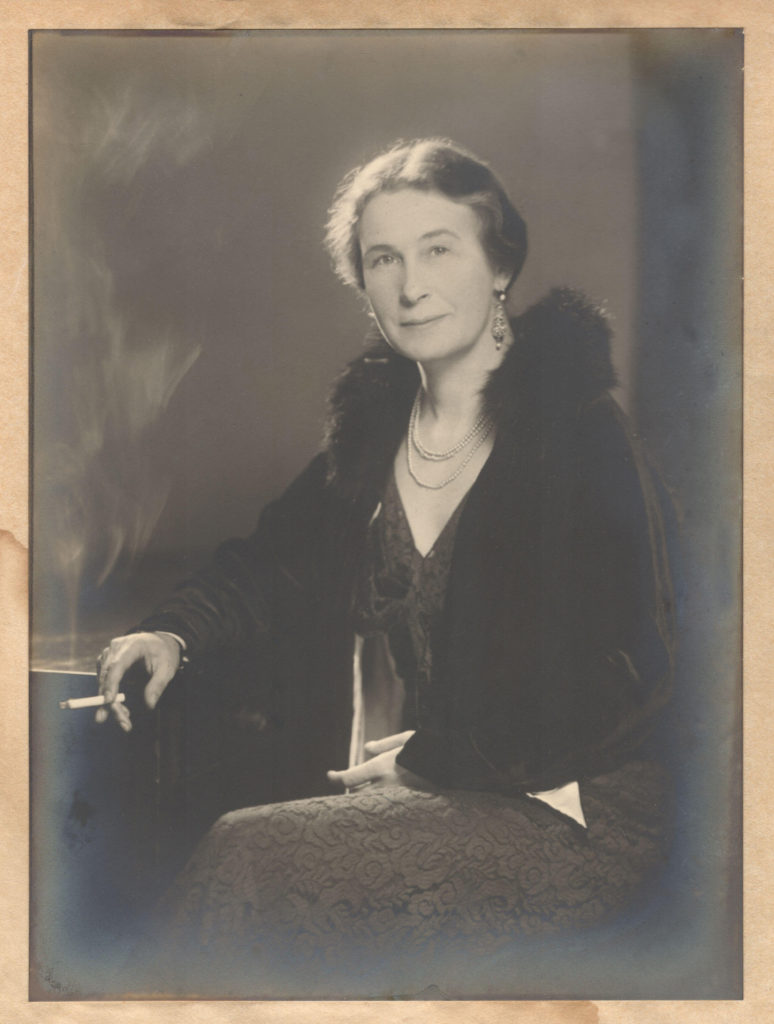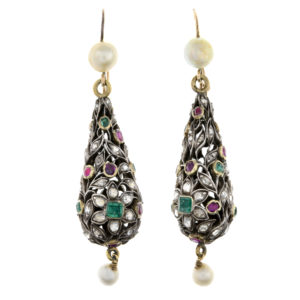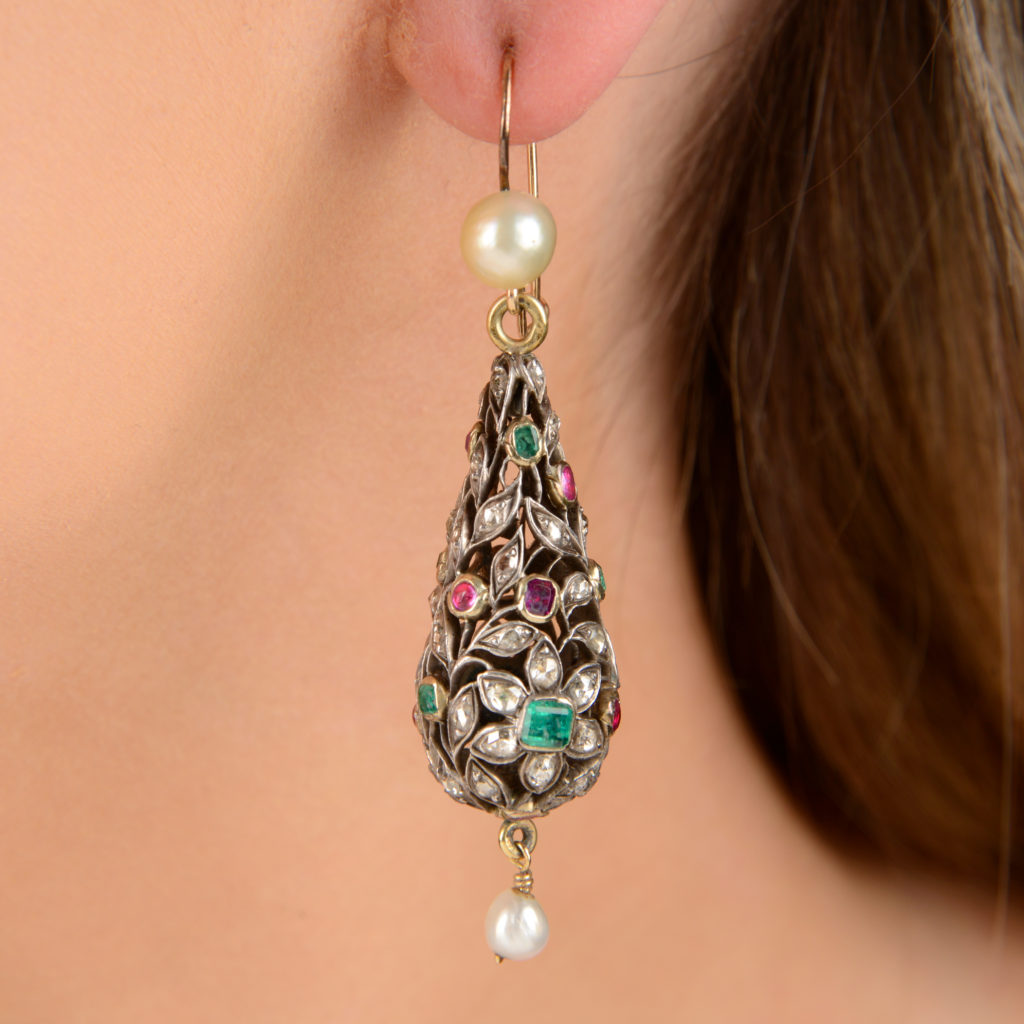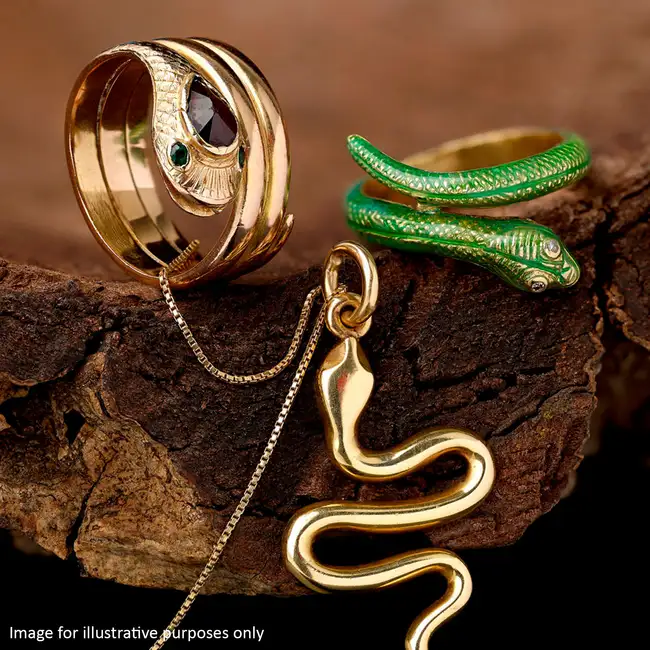Lady King was the wife of Sir Carlton King, a chief justice of the Indian Civil Service. They had three daughters and resided in Lucknow, Allahabad and Delhi, with summers spent in Nainital. Also known as 'Fanny', Lady King's mother was related to two well-known Indian artists' families: the Daniells and Princeps. After Sir Carlton King ended his career at the Delhi High Court, the Kings returned to England in the 1930s.

Lady King's Earrings
These earrings show a typical torpedo-shaped drop Indian design of the 1830s and 1840s, featuring diamonds, rubies, and emeralds. We can assume from this style that they date from mid-nineteenth century India.
One of the oldest techniques, introduced to India by the Mughals and perfected by skilled Indian craftsmen, is the jadayi style. This is a technique of embedding gems into gold as a framework without using adhesive, typically with a foil backing. This is a laborious process taking many days of skilled, careful work. The floral design is typical of Indian work since the Mughal period. While these earrings are in this classical Indian style, they also show the European influence of the time by setting the diamonds in silver, with the coloured gems only set in gold.

Indian Jewellery
This combination of an extravagant over-sized European design, mixture of metals, technique, and variety of gemstone cuttings can only be found at this one brief moment of a wonderful culmination of Anglo-Indian design.
The 18th century British Raj adapted their style to their surroundings. As it was acceptable to appear on equal terms with the Nawabs. Gifts were swapped between potentates and so a new wave of cultural exchange began. Precious stones were acquired, with one of the gains easily brought back to England as transportable currency.
Over time, more Ladies came to India in search of husbands. The desire was to follow European fashion but sending orders to London and back was not a timely enterprise. This led to the demand for locally made jewellery increasing.
Few European jewellers settled in India, with many of their workers themselves natives. In Bombay, in 1864 it was noted that there were 10,670 native goldsmiths, compared to twenty Europeans. Indian jewellers had a singular ability to adapt their manufacture to suit foreign influences. They were able to replicate the styles that had been presented to them.
The Popularity of Indian Jewellery
As Indian jewels made their way to England, the Empress of India had a significant appreciation for the styles and forms associated, along with the fashionable aesthetes who also collected the jewels. Notables such as John Ruskin favoured the cabochon cut, harking to the manual labour of the artisans and with Queen Victoria wearing ‘uncut’ gems, the fashion spread throughout the nation. Pieces bought from International Exhibitions by the South Kensington Museum (now known as the Victoria & Albert Museum) secured access to designs to a wider audience.
Soon, more recognised jewellers such as Giuliano adapted motifs, colours and forms, integrating Indian jewellery into the English mainstream.
In the early 20th century another resurgence of Indian taste hit European shores. In 1911 George V’s Coronation durbar in Delhi brought Cartier into contact with influential and fashionable Maharajahs. They brought swathes of Indian colour and gemstones to be re-set to European taste. These bright colours and bold, repeating designs complemented the emerging Art Deco style and re-invigorated interest in Indian taste.
Indian Jewellery at Auction

19th c. diamond, pearl, ruby & emerald earrings, previously belonging to Lady King.
Price Realised: £7,280.00
Fine Jewellery | Thursday 21st March 2024
Viewing times (ID required):
London
Monday 11th March 10:00-19:00
Tuesday 12th March 09:30-11:30
Birmingham
Tuesday 19th March 10:00-16:00
Wednesday 20th March 10:00-16:00
Thursday 21st March 8:30-09:00
Virtual viewings are available by request. Virtual viewings are the ultimate personal shopping experience. Using Zoom, you can ask us whatever you need to know in order to buy with confidence. Find out more here.
Valuations
Our valuations are free, with no obligation to sell with us. Our experts will value your item with an estimate, so you can find out what it could achieve at auction.
The process is simple. You can fill in a form online or book an appointment to visit either of our offices in Birmingham or London. Virtual valuation appointments are also available.
Find what you're looking for
Make sure you don’t miss finding that special something by signing up to our email alerts. You’ll be the first to know when catalogues become available, receive invitations to special events and preview the hottest lots from our auctions, plus much more.
Why not use our free personal shopping service? Sign up for lot alerts and tell us exactly what you are looking for. Each time we upload a catalogue, we search for your keywords and email you lots matching your interests. Your personalised email will include images, lot descriptions and auction details.
Ben Randall | BA (Hons), GG, AJP













